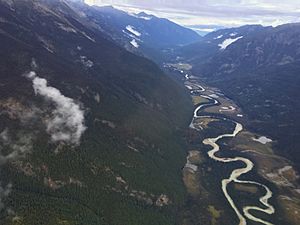Raush River facts for kids
The Raush River is a cool river in British Columbia, Canada. It flows into the much bigger Fraser River. Think of it like a smaller road that joins a main highway! The Raush River helps drain a large area of land, about 100,000 hectares (that's like 250,000 football fields!), on the eastern side of the Cariboo Mountains. These mountains are part of the even larger Columbia Mountains range. The Raush River meets the Fraser River near a small community called Dunster in the Robson Valley.
The river's name, "Raush," is a bit of a funny story! It was originally called Rivière au Shuswap, which means "River of the Shuswap people." On some old maps, this was shortened to R.auSh., and over time, it just became "Raush" on official maps. The river starts high up at the Raush Glacier, and some smaller streams, like Black Martin and Quanstrom creeks, flow into it.
Exploring the Raush River
The Raush River is a great place for outdoor adventures. More than 50 kilometers (about 31 miles) of the river are easy to travel on. This makes it perfect for people who love to explore by water!
River Activities
- Kayaking: People use small, narrow boats called kayaks to paddle down the river. It's a fun way to see nature up close.
- Canoeing: Canoes are larger boats, often used by two or more people. They're great for a relaxed trip down the river.
- Jetboating: Some people use fast boats called jetboats. These boats use a jet of water to move, which helps them travel in shallower parts of the river.
Protecting the Raush River
To keep the Raush River and its surroundings healthy, two special areas have been set aside for protection. These areas help make sure the plants, animals, and natural beauty of the river are safe for the future.
Protected Areas
- Lower Raush Protected Area: This area covers 1,279 hectares (about 3,160 acres) near where the river joins the Fraser. It protects the lower parts of the river.
- Upper Raush Protected Area: This larger area covers 5,582 hectares (about 13,793 acres) in the river's upper reaches, closer to its source.
These protected areas are important because they help keep the river's ecosystem balanced. They ensure that the river remains a clean and beautiful place for both wildlife and people to enjoy.


